Primary Care Vs. Urgent Treatment: Recognizing When To Look For Each Service

Content Create By-Ohlsen Schultz
When it pertains to your health, recognizing whether to select health care or immediate care can be vital. Comprehending the differences between these two services and identifying the specific situations where each sparkles is important for making informed choices regarding your clinical demands. By comprehending the nuances of medical care and urgent care, you can navigate the medical care landscape better and make sure that you receive the appropriate level of interest when looking for treatment.
Key Distinctions In Between Primary Care and Urgent Care
Wondering exactly how health care varies from urgent treatment and when to select each? Let's simplify for you. Medical care concentrates on preventive treatment and managing overall health and wellness. You go to a health care medical professional for routine exams, inoculations, screenings, and recurring health concerns. This sort of care establishes a lasting partnership with a healthcare provider that recognizes your case history and can assist you through various health issues.
On the other hand, urgent treatment is for immediate clinical demands that occur all of a sudden. If you have a minor injury or health problem that needs prompt interest however isn't serious, immediate care centers are equipped to handle it. They supply extended hours and walk-in visits, making them practical for abrupt health problems that can not await a health care visit.
Elements to Consider Prior To Deciding On Treatment
Before choosing in between health care and immediate treatment, take into consideration reviewing the extent of your clinical concern and the urgency of therapy required.
Initially, assess the severity of your signs. If you're experiencing mild symptoms like a common cold, breakout, or minor sprain, health care might be suitable. On the other hand, if you have severe signs such as chest discomfort, trouble breathing, extreme allergic reactions, or deep cuts requiring instant focus, urgent treatment is likely better suited.
Additionally, take into consideration the moment of day and day of the week. Health care facilities generally operate during regular service hours, while immediate care facilities often supply prolonged hours and weekend schedule.
Another element to contemplate is cost. https://zenwriting.net/dwain77caprice/partnering-with-the-right-primary-care-center-can-be-pivotal-for-your-health through are typically extra costly than primary care sees, so if cost is an issue, primary care might be the extra affordable choice.
Understanding When to Look For Urgent Care
To determine when to seek urgent treatment as opposed to health care, assess the extent and necessity of your medical problem, concentrating on signs like breast pain, difficulty breathing, severe allergies, or deep cuts that require prompt attention.
If you experience abrupt and extreme breast pain, especially if it emits to your arm or jaw, it might show a cardiac arrest, necessitating immediate medical evaluation. Likewise, trouble breathing, especially if it begins instantly or is accompanied by breast tightness or wheezing, may symbolize a major respiratory system trouble that calls for timely attention at an immediate care facility.
Severe allergic reactions, such as swelling of the face or throat, hives throughout the body, or difficulty swallowing, can suggest anaphylaxis, a dangerous problem that requires prompt treatment. Deep cuts that are bleeding a lot, gaping open, or exposing underlying cells ought to be assessed at immediate care to prevent infection and make certain proper injury closure.
If https://www.bristol.ac.uk/news/2023/september/obesity-stigma.html experience any one of these signs, looking for urgent care quickly is vital for your health and well-being.
Final thought
Ultimately, recognizing the difference between health care and immediate treatment is critical in ensuring you obtain the appropriate level of clinical focus for your requirements.
By taking into consideration variables such as the intensity of signs and symptoms, time constraints, and facility accessibility, you can make a notified choice on whether to look for regular treatment from a primary care service provider or instant focus from an urgent treatment center.
Prioritizing your health and wellness and wellness starts with recognizing when to seek each service.

